Texas Education: No Child Left Behind and Every Student Succeeds
VerifiedAdded on 2022/08/10
|8
|1771
|31
Report
AI Summary
This report provides an in-depth analysis of Texas's K-12 public education policy, focusing on the No Child Left Behind Act and the Every Student Succeeds Act. It begins with an introduction explaining the importance of the topic and the focus of the analysis. The report then delves into the historical context of the policy, tracing its origins and development within the Texas government, including key legislation and constitutional amendments related to education. The evolution of the public school system in Texas is examined, including enrollment figures, teacher-student ratios, and financial allocations. The report also explores the social and personal responsibility aspects of the policy, including initiatives aimed at improving the education system and providing school choice options for parents. The analysis concludes with an assessment of the policy's impact and effectiveness, drawing on research to evaluate its successes and shortcomings. The report utilizes MLA citation and references multiple sources to support its claims.
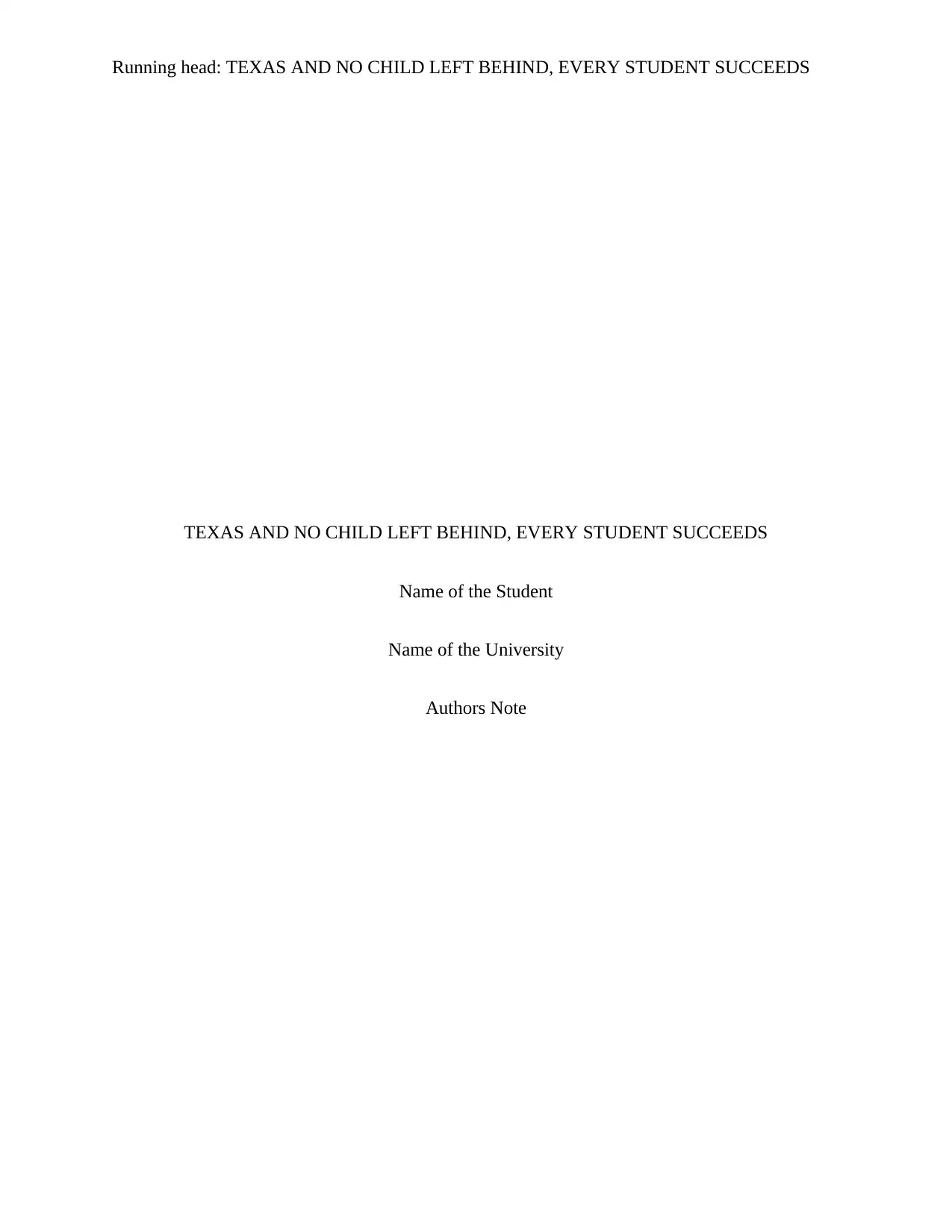
Running head: TEXAS AND NO CHILD LEFT BEHIND, EVERY STUDENT SUCCEEDS
TEXAS AND NO CHILD LEFT BEHIND, EVERY STUDENT SUCCEEDS
Name of the Student
Name of the University
Authors Note
TEXAS AND NO CHILD LEFT BEHIND, EVERY STUDENT SUCCEEDS
Name of the Student
Name of the University
Authors Note
Paraphrase This Document
Need a fresh take? Get an instant paraphrase of this document with our AI Paraphraser
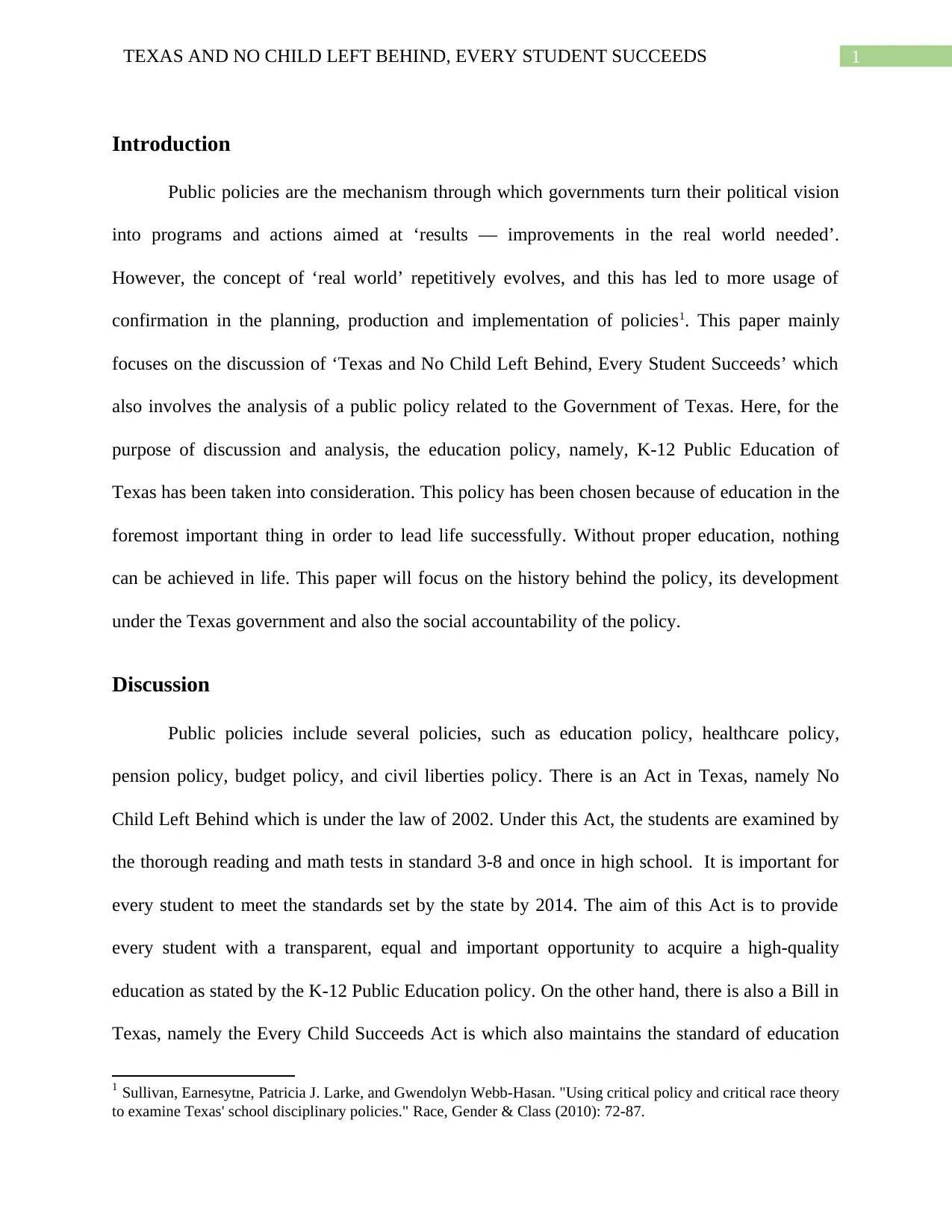
1TEXAS AND NO CHILD LEFT BEHIND, EVERY STUDENT SUCCEEDS
Introduction
Public policies are the mechanism through which governments turn their political vision
into programs and actions aimed at ‘results — improvements in the real world needed’.
However, the concept of ‘real world’ repetitively evolves, and this has led to more usage of
confirmation in the planning, production and implementation of policies1. This paper mainly
focuses on the discussion of ‘Texas and No Child Left Behind, Every Student Succeeds’ which
also involves the analysis of a public policy related to the Government of Texas. Here, for the
purpose of discussion and analysis, the education policy, namely, K-12 Public Education of
Texas has been taken into consideration. This policy has been chosen because of education in the
foremost important thing in order to lead life successfully. Without proper education, nothing
can be achieved in life. This paper will focus on the history behind the policy, its development
under the Texas government and also the social accountability of the policy.
Discussion
Public policies include several policies, such as education policy, healthcare policy,
pension policy, budget policy, and civil liberties policy. There is an Act in Texas, namely No
Child Left Behind which is under the law of 2002. Under this Act, the students are examined by
the thorough reading and math tests in standard 3-8 and once in high school. It is important for
every student to meet the standards set by the state by 2014. The aim of this Act is to provide
every student with a transparent, equal and important opportunity to acquire a high-quality
education as stated by the K-12 Public Education policy. On the other hand, there is also a Bill in
Texas, namely the Every Child Succeeds Act is which also maintains the standard of education
1 Sullivan, Earnesytne, Patricia J. Larke, and Gwendolyn Webb-Hasan. "Using critical policy and critical race theory
to examine Texas' school disciplinary policies." Race, Gender & Class (2010): 72-87.
Introduction
Public policies are the mechanism through which governments turn their political vision
into programs and actions aimed at ‘results — improvements in the real world needed’.
However, the concept of ‘real world’ repetitively evolves, and this has led to more usage of
confirmation in the planning, production and implementation of policies1. This paper mainly
focuses on the discussion of ‘Texas and No Child Left Behind, Every Student Succeeds’ which
also involves the analysis of a public policy related to the Government of Texas. Here, for the
purpose of discussion and analysis, the education policy, namely, K-12 Public Education of
Texas has been taken into consideration. This policy has been chosen because of education in the
foremost important thing in order to lead life successfully. Without proper education, nothing
can be achieved in life. This paper will focus on the history behind the policy, its development
under the Texas government and also the social accountability of the policy.
Discussion
Public policies include several policies, such as education policy, healthcare policy,
pension policy, budget policy, and civil liberties policy. There is an Act in Texas, namely No
Child Left Behind which is under the law of 2002. Under this Act, the students are examined by
the thorough reading and math tests in standard 3-8 and once in high school. It is important for
every student to meet the standards set by the state by 2014. The aim of this Act is to provide
every student with a transparent, equal and important opportunity to acquire a high-quality
education as stated by the K-12 Public Education policy. On the other hand, there is also a Bill in
Texas, namely the Every Child Succeeds Act is which also maintains the standard of education
1 Sullivan, Earnesytne, Patricia J. Larke, and Gwendolyn Webb-Hasan. "Using critical policy and critical race theory
to examine Texas' school disciplinary policies." Race, Gender & Class (2010): 72-87.
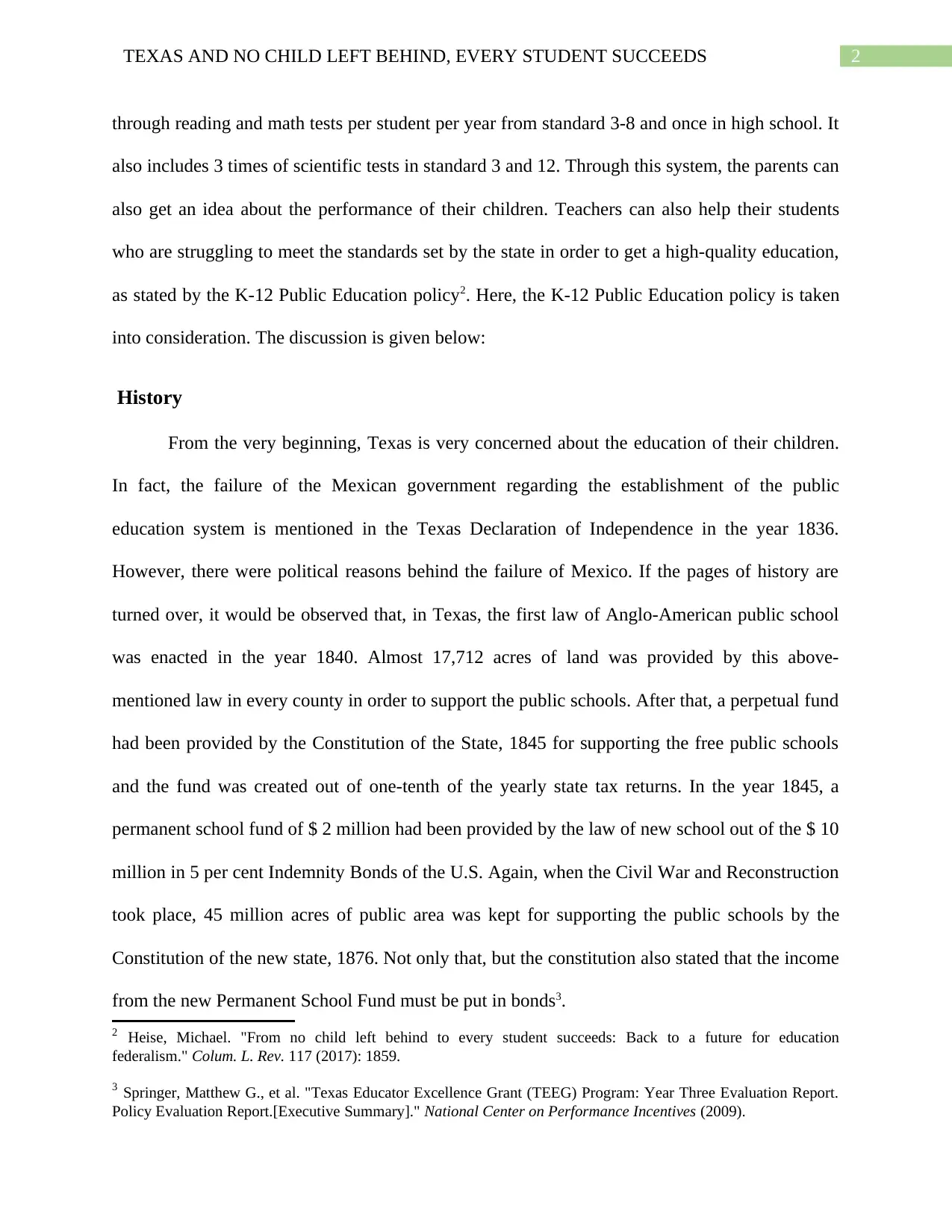
2TEXAS AND NO CHILD LEFT BEHIND, EVERY STUDENT SUCCEEDS
through reading and math tests per student per year from standard 3-8 and once in high school. It
also includes 3 times of scientific tests in standard 3 and 12. Through this system, the parents can
also get an idea about the performance of their children. Teachers can also help their students
who are struggling to meet the standards set by the state in order to get a high-quality education,
as stated by the K-12 Public Education policy2. Here, the K-12 Public Education policy is taken
into consideration. The discussion is given below:
History
From the very beginning, Texas is very concerned about the education of their children.
In fact, the failure of the Mexican government regarding the establishment of the public
education system is mentioned in the Texas Declaration of Independence in the year 1836.
However, there were political reasons behind the failure of Mexico. If the pages of history are
turned over, it would be observed that, in Texas, the first law of Anglo-American public school
was enacted in the year 1840. Almost 17,712 acres of land was provided by this above-
mentioned law in every county in order to support the public schools. After that, a perpetual fund
had been provided by the Constitution of the State, 1845 for supporting the free public schools
and the fund was created out of one-tenth of the yearly state tax returns. In the year 1845, a
permanent school fund of $ 2 million had been provided by the law of new school out of the $ 10
million in 5 per cent Indemnity Bonds of the U.S. Again, when the Civil War and Reconstruction
took place, 45 million acres of public area was kept for supporting the public schools by the
Constitution of the new state, 1876. Not only that, but the constitution also stated that the income
from the new Permanent School Fund must be put in bonds3.
2 Heise, Michael. "From no child left behind to every student succeeds: Back to a future for education
federalism." Colum. L. Rev. 117 (2017): 1859.
3 Springer, Matthew G., et al. "Texas Educator Excellence Grant (TEEG) Program: Year Three Evaluation Report.
Policy Evaluation Report.[Executive Summary]." National Center on Performance Incentives (2009).
through reading and math tests per student per year from standard 3-8 and once in high school. It
also includes 3 times of scientific tests in standard 3 and 12. Through this system, the parents can
also get an idea about the performance of their children. Teachers can also help their students
who are struggling to meet the standards set by the state in order to get a high-quality education,
as stated by the K-12 Public Education policy2. Here, the K-12 Public Education policy is taken
into consideration. The discussion is given below:
History
From the very beginning, Texas is very concerned about the education of their children.
In fact, the failure of the Mexican government regarding the establishment of the public
education system is mentioned in the Texas Declaration of Independence in the year 1836.
However, there were political reasons behind the failure of Mexico. If the pages of history are
turned over, it would be observed that, in Texas, the first law of Anglo-American public school
was enacted in the year 1840. Almost 17,712 acres of land was provided by this above-
mentioned law in every county in order to support the public schools. After that, a perpetual fund
had been provided by the Constitution of the State, 1845 for supporting the free public schools
and the fund was created out of one-tenth of the yearly state tax returns. In the year 1845, a
permanent school fund of $ 2 million had been provided by the law of new school out of the $ 10
million in 5 per cent Indemnity Bonds of the U.S. Again, when the Civil War and Reconstruction
took place, 45 million acres of public area was kept for supporting the public schools by the
Constitution of the new state, 1876. Not only that, but the constitution also stated that the income
from the new Permanent School Fund must be put in bonds3.
2 Heise, Michael. "From no child left behind to every student succeeds: Back to a future for education
federalism." Colum. L. Rev. 117 (2017): 1859.
3 Springer, Matthew G., et al. "Texas Educator Excellence Grant (TEEG) Program: Year Three Evaluation Report.
Policy Evaluation Report.[Executive Summary]." National Center on Performance Incentives (2009).
⊘ This is a preview!⊘
Do you want full access?
Subscribe today to unlock all pages.

Trusted by 1+ million students worldwide
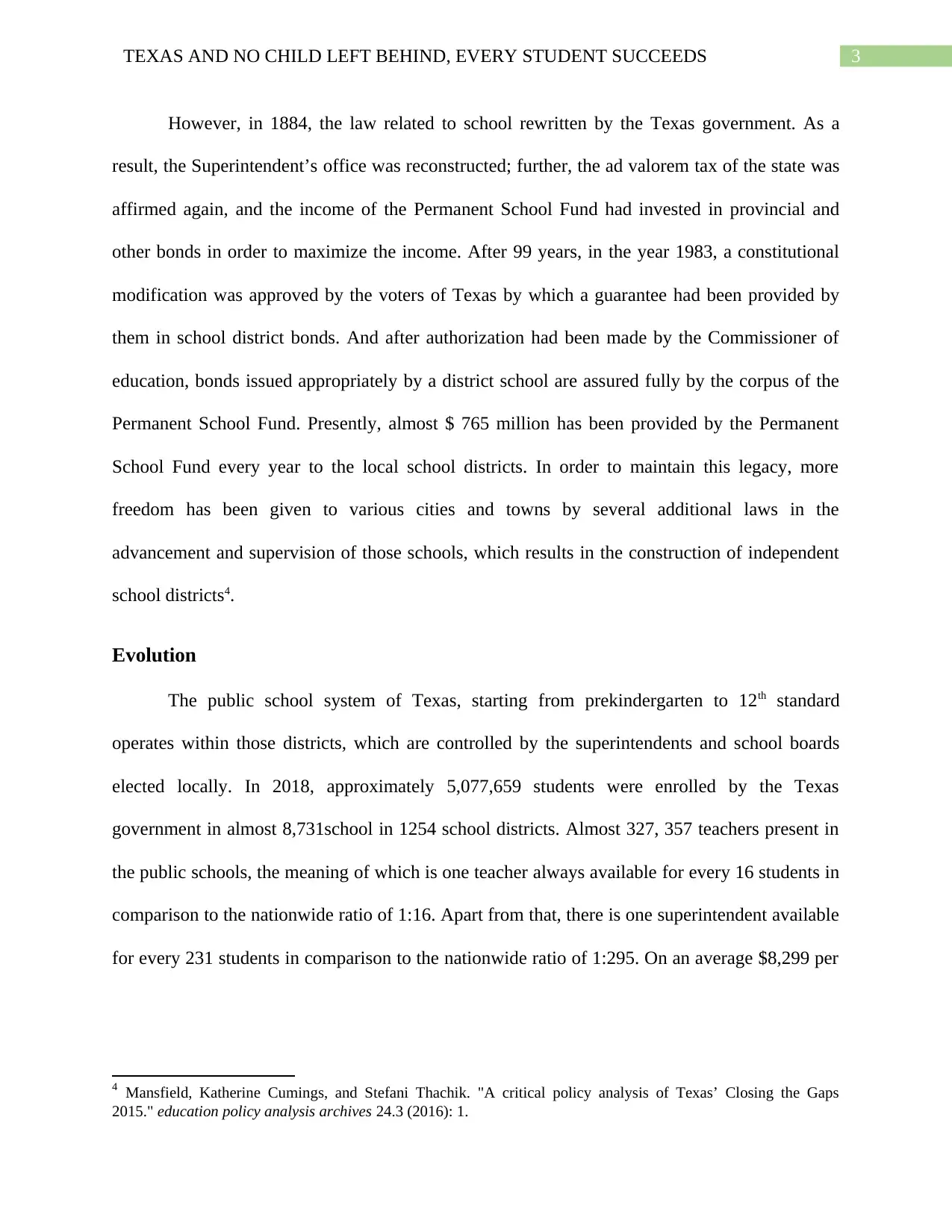
3TEXAS AND NO CHILD LEFT BEHIND, EVERY STUDENT SUCCEEDS
However, in 1884, the law related to school rewritten by the Texas government. As a
result, the Superintendent’s office was reconstructed; further, the ad valorem tax of the state was
affirmed again, and the income of the Permanent School Fund had invested in provincial and
other bonds in order to maximize the income. After 99 years, in the year 1983, a constitutional
modification was approved by the voters of Texas by which a guarantee had been provided by
them in school district bonds. And after authorization had been made by the Commissioner of
education, bonds issued appropriately by a district school are assured fully by the corpus of the
Permanent School Fund. Presently, almost $ 765 million has been provided by the Permanent
School Fund every year to the local school districts. In order to maintain this legacy, more
freedom has been given to various cities and towns by several additional laws in the
advancement and supervision of those schools, which results in the construction of independent
school districts4.
Evolution
The public school system of Texas, starting from prekindergarten to 12th standard
operates within those districts, which are controlled by the superintendents and school boards
elected locally. In 2018, approximately 5,077,659 students were enrolled by the Texas
government in almost 8,731school in 1254 school districts. Almost 327, 357 teachers present in
the public schools, the meaning of which is one teacher always available for every 16 students in
comparison to the nationwide ratio of 1:16. Apart from that, there is one superintendent available
for every 231 students in comparison to the nationwide ratio of 1:295. On an average $8,299 per
4 Mansfield, Katherine Cumings, and Stefani Thachik. "A critical policy analysis of Texas’ Closing the Gaps
2015." education policy analysis archives 24.3 (2016): 1.
However, in 1884, the law related to school rewritten by the Texas government. As a
result, the Superintendent’s office was reconstructed; further, the ad valorem tax of the state was
affirmed again, and the income of the Permanent School Fund had invested in provincial and
other bonds in order to maximize the income. After 99 years, in the year 1983, a constitutional
modification was approved by the voters of Texas by which a guarantee had been provided by
them in school district bonds. And after authorization had been made by the Commissioner of
education, bonds issued appropriately by a district school are assured fully by the corpus of the
Permanent School Fund. Presently, almost $ 765 million has been provided by the Permanent
School Fund every year to the local school districts. In order to maintain this legacy, more
freedom has been given to various cities and towns by several additional laws in the
advancement and supervision of those schools, which results in the construction of independent
school districts4.
Evolution
The public school system of Texas, starting from prekindergarten to 12th standard
operates within those districts, which are controlled by the superintendents and school boards
elected locally. In 2018, approximately 5,077,659 students were enrolled by the Texas
government in almost 8,731school in 1254 school districts. Almost 327, 357 teachers present in
the public schools, the meaning of which is one teacher always available for every 16 students in
comparison to the nationwide ratio of 1:16. Apart from that, there is one superintendent available
for every 231 students in comparison to the nationwide ratio of 1:295. On an average $8,299 per
4 Mansfield, Katherine Cumings, and Stefani Thachik. "A critical policy analysis of Texas’ Closing the Gaps
2015." education policy analysis archives 24.3 (2016): 1.
Paraphrase This Document
Need a fresh take? Get an instant paraphrase of this document with our AI Paraphraser
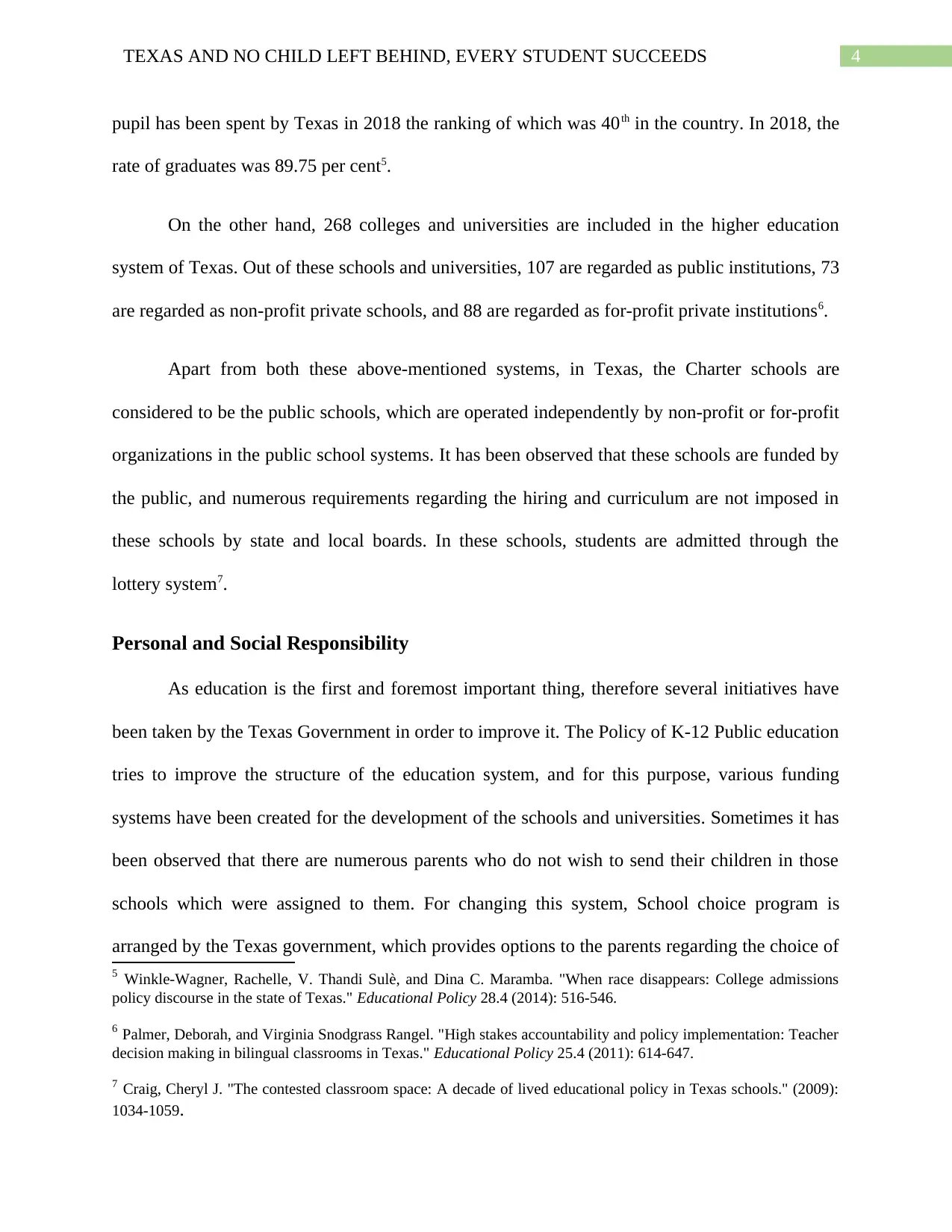
4TEXAS AND NO CHILD LEFT BEHIND, EVERY STUDENT SUCCEEDS
pupil has been spent by Texas in 2018 the ranking of which was 40th in the country. In 2018, the
rate of graduates was 89.75 per cent5.
On the other hand, 268 colleges and universities are included in the higher education
system of Texas. Out of these schools and universities, 107 are regarded as public institutions, 73
are regarded as non-profit private schools, and 88 are regarded as for-profit private institutions6.
Apart from both these above-mentioned systems, in Texas, the Charter schools are
considered to be the public schools, which are operated independently by non-profit or for-profit
organizations in the public school systems. It has been observed that these schools are funded by
the public, and numerous requirements regarding the hiring and curriculum are not imposed in
these schools by state and local boards. In these schools, students are admitted through the
lottery system7.
Personal and Social Responsibility
As education is the first and foremost important thing, therefore several initiatives have
been taken by the Texas Government in order to improve it. The Policy of K-12 Public education
tries to improve the structure of the education system, and for this purpose, various funding
systems have been created for the development of the schools and universities. Sometimes it has
been observed that there are numerous parents who do not wish to send their children in those
schools which were assigned to them. For changing this system, School choice program is
arranged by the Texas government, which provides options to the parents regarding the choice of
5 Winkle-Wagner, Rachelle, V. Thandi Sulè, and Dina C. Maramba. "When race disappears: College admissions
policy discourse in the state of Texas." Educational Policy 28.4 (2014): 516-546.
6 Palmer, Deborah, and Virginia Snodgrass Rangel. "High stakes accountability and policy implementation: Teacher
decision making in bilingual classrooms in Texas." Educational Policy 25.4 (2011): 614-647.
7 Craig, Cheryl J. "The contested classroom space: A decade of lived educational policy in Texas schools." (2009):
1034-1059.
pupil has been spent by Texas in 2018 the ranking of which was 40th in the country. In 2018, the
rate of graduates was 89.75 per cent5.
On the other hand, 268 colleges and universities are included in the higher education
system of Texas. Out of these schools and universities, 107 are regarded as public institutions, 73
are regarded as non-profit private schools, and 88 are regarded as for-profit private institutions6.
Apart from both these above-mentioned systems, in Texas, the Charter schools are
considered to be the public schools, which are operated independently by non-profit or for-profit
organizations in the public school systems. It has been observed that these schools are funded by
the public, and numerous requirements regarding the hiring and curriculum are not imposed in
these schools by state and local boards. In these schools, students are admitted through the
lottery system7.
Personal and Social Responsibility
As education is the first and foremost important thing, therefore several initiatives have
been taken by the Texas Government in order to improve it. The Policy of K-12 Public education
tries to improve the structure of the education system, and for this purpose, various funding
systems have been created for the development of the schools and universities. Sometimes it has
been observed that there are numerous parents who do not wish to send their children in those
schools which were assigned to them. For changing this system, School choice program is
arranged by the Texas government, which provides options to the parents regarding the choice of
5 Winkle-Wagner, Rachelle, V. Thandi Sulè, and Dina C. Maramba. "When race disappears: College admissions
policy discourse in the state of Texas." Educational Policy 28.4 (2014): 516-546.
6 Palmer, Deborah, and Virginia Snodgrass Rangel. "High stakes accountability and policy implementation: Teacher
decision making in bilingual classrooms in Texas." Educational Policy 25.4 (2011): 614-647.
7 Craig, Cheryl J. "The contested classroom space: A decade of lived educational policy in Texas schools." (2009):
1034-1059.
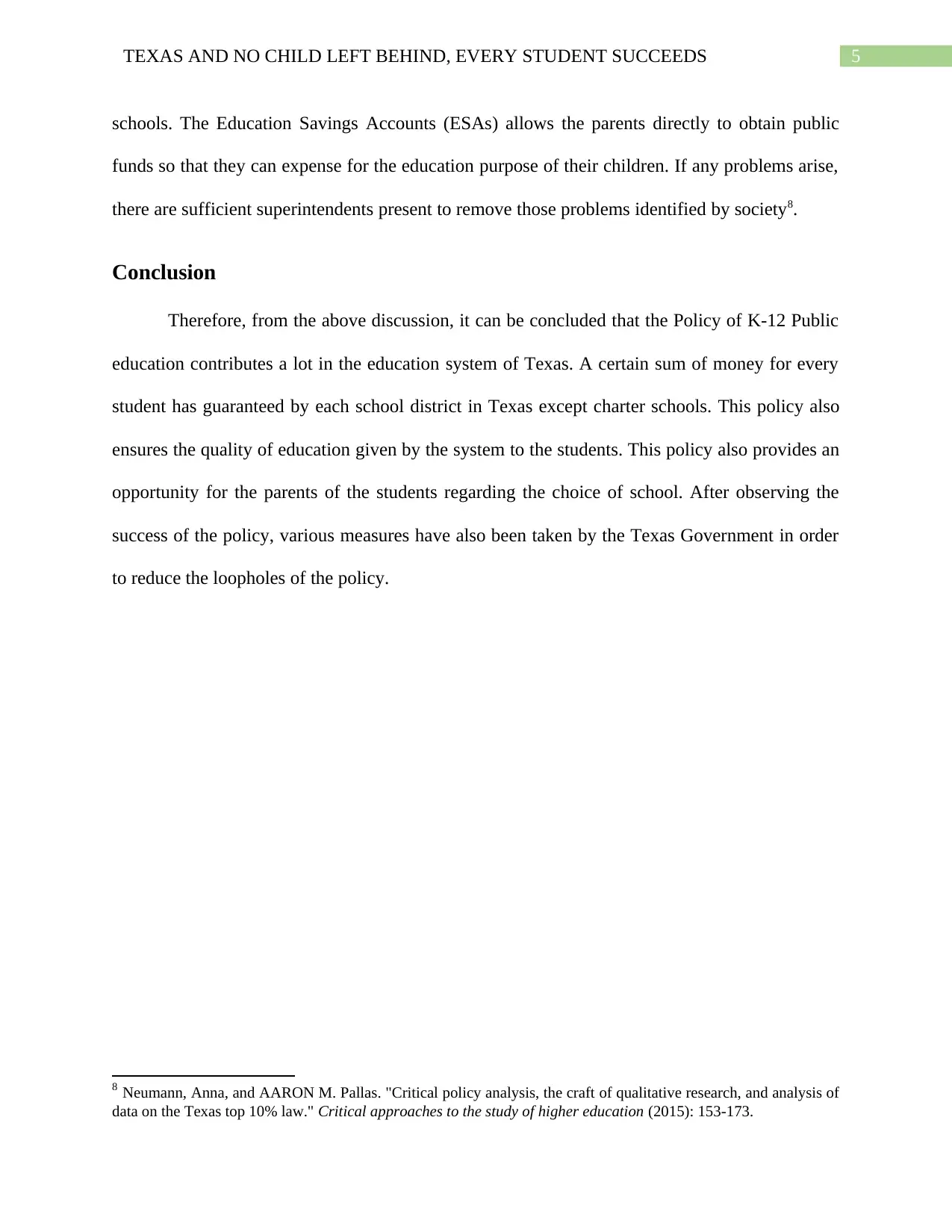
5TEXAS AND NO CHILD LEFT BEHIND, EVERY STUDENT SUCCEEDS
schools. The Education Savings Accounts (ESAs) allows the parents directly to obtain public
funds so that they can expense for the education purpose of their children. If any problems arise,
there are sufficient superintendents present to remove those problems identified by society8.
Conclusion
Therefore, from the above discussion, it can be concluded that the Policy of K-12 Public
education contributes a lot in the education system of Texas. A certain sum of money for every
student has guaranteed by each school district in Texas except charter schools. This policy also
ensures the quality of education given by the system to the students. This policy also provides an
opportunity for the parents of the students regarding the choice of school. After observing the
success of the policy, various measures have also been taken by the Texas Government in order
to reduce the loopholes of the policy.
8 Neumann, Anna, and AARON M. Pallas. "Critical policy analysis, the craft of qualitative research, and analysis of
data on the Texas top 10% law." Critical approaches to the study of higher education (2015): 153-173.
schools. The Education Savings Accounts (ESAs) allows the parents directly to obtain public
funds so that they can expense for the education purpose of their children. If any problems arise,
there are sufficient superintendents present to remove those problems identified by society8.
Conclusion
Therefore, from the above discussion, it can be concluded that the Policy of K-12 Public
education contributes a lot in the education system of Texas. A certain sum of money for every
student has guaranteed by each school district in Texas except charter schools. This policy also
ensures the quality of education given by the system to the students. This policy also provides an
opportunity for the parents of the students regarding the choice of school. After observing the
success of the policy, various measures have also been taken by the Texas Government in order
to reduce the loopholes of the policy.
8 Neumann, Anna, and AARON M. Pallas. "Critical policy analysis, the craft of qualitative research, and analysis of
data on the Texas top 10% law." Critical approaches to the study of higher education (2015): 153-173.
⊘ This is a preview!⊘
Do you want full access?
Subscribe today to unlock all pages.

Trusted by 1+ million students worldwide
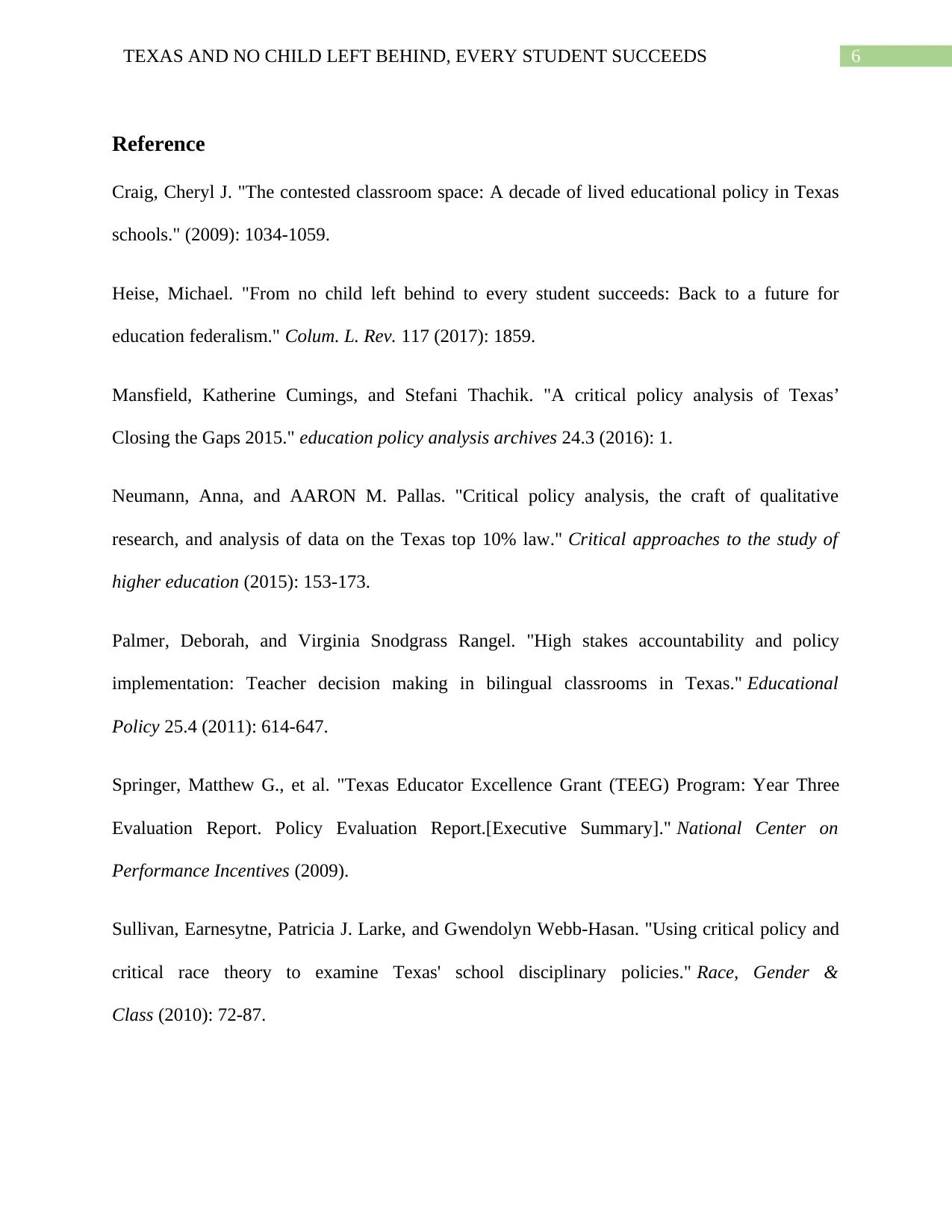
6TEXAS AND NO CHILD LEFT BEHIND, EVERY STUDENT SUCCEEDS
Reference
Craig, Cheryl J. "The contested classroom space: A decade of lived educational policy in Texas
schools." (2009): 1034-1059.
Heise, Michael. "From no child left behind to every student succeeds: Back to a future for
education federalism." Colum. L. Rev. 117 (2017): 1859.
Mansfield, Katherine Cumings, and Stefani Thachik. "A critical policy analysis of Texas’
Closing the Gaps 2015." education policy analysis archives 24.3 (2016): 1.
Neumann, Anna, and AARON M. Pallas. "Critical policy analysis, the craft of qualitative
research, and analysis of data on the Texas top 10% law." Critical approaches to the study of
higher education (2015): 153-173.
Palmer, Deborah, and Virginia Snodgrass Rangel. "High stakes accountability and policy
implementation: Teacher decision making in bilingual classrooms in Texas." Educational
Policy 25.4 (2011): 614-647.
Springer, Matthew G., et al. "Texas Educator Excellence Grant (TEEG) Program: Year Three
Evaluation Report. Policy Evaluation Report.[Executive Summary]." National Center on
Performance Incentives (2009).
Sullivan, Earnesytne, Patricia J. Larke, and Gwendolyn Webb-Hasan. "Using critical policy and
critical race theory to examine Texas' school disciplinary policies." Race, Gender &
Class (2010): 72-87.
Reference
Craig, Cheryl J. "The contested classroom space: A decade of lived educational policy in Texas
schools." (2009): 1034-1059.
Heise, Michael. "From no child left behind to every student succeeds: Back to a future for
education federalism." Colum. L. Rev. 117 (2017): 1859.
Mansfield, Katherine Cumings, and Stefani Thachik. "A critical policy analysis of Texas’
Closing the Gaps 2015." education policy analysis archives 24.3 (2016): 1.
Neumann, Anna, and AARON M. Pallas. "Critical policy analysis, the craft of qualitative
research, and analysis of data on the Texas top 10% law." Critical approaches to the study of
higher education (2015): 153-173.
Palmer, Deborah, and Virginia Snodgrass Rangel. "High stakes accountability and policy
implementation: Teacher decision making in bilingual classrooms in Texas." Educational
Policy 25.4 (2011): 614-647.
Springer, Matthew G., et al. "Texas Educator Excellence Grant (TEEG) Program: Year Three
Evaluation Report. Policy Evaluation Report.[Executive Summary]." National Center on
Performance Incentives (2009).
Sullivan, Earnesytne, Patricia J. Larke, and Gwendolyn Webb-Hasan. "Using critical policy and
critical race theory to examine Texas' school disciplinary policies." Race, Gender &
Class (2010): 72-87.
Paraphrase This Document
Need a fresh take? Get an instant paraphrase of this document with our AI Paraphraser
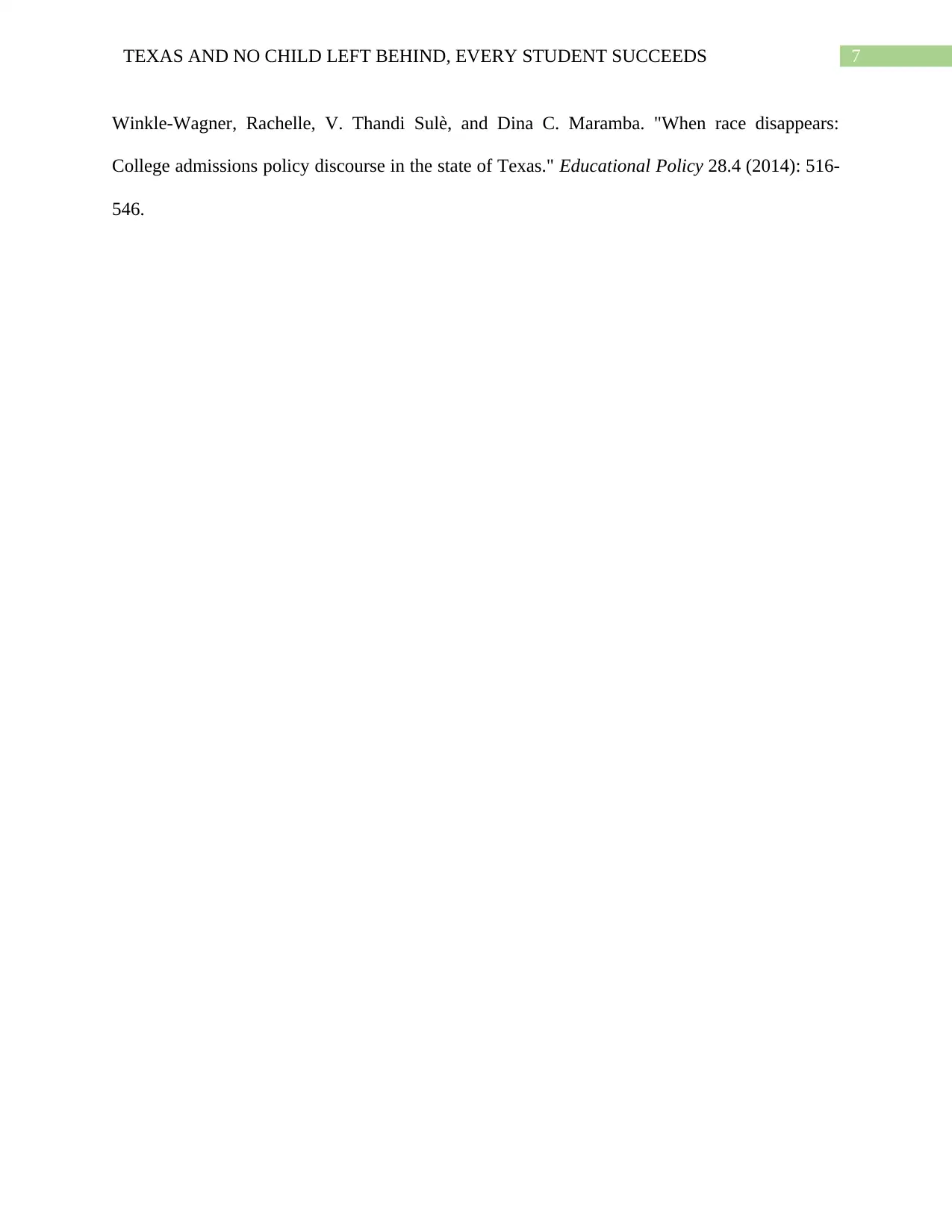
7TEXAS AND NO CHILD LEFT BEHIND, EVERY STUDENT SUCCEEDS
Winkle-Wagner, Rachelle, V. Thandi Sulè, and Dina C. Maramba. "When race disappears:
College admissions policy discourse in the state of Texas." Educational Policy 28.4 (2014): 516-
546.
Winkle-Wagner, Rachelle, V. Thandi Sulè, and Dina C. Maramba. "When race disappears:
College admissions policy discourse in the state of Texas." Educational Policy 28.4 (2014): 516-
546.
1 out of 8
Related Documents
Your All-in-One AI-Powered Toolkit for Academic Success.
+13062052269
info@desklib.com
Available 24*7 on WhatsApp / Email
![[object Object]](/_next/static/media/star-bottom.7253800d.svg)
Unlock your academic potential
Copyright © 2020–2025 A2Z Services. All Rights Reserved. Developed and managed by ZUCOL.




